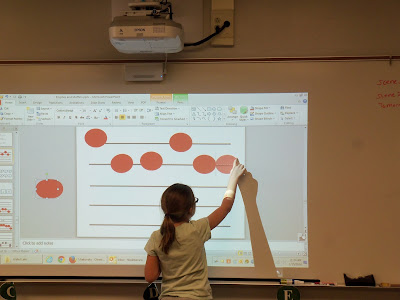Kindergarten students learned a new song entitled Punchinella. This song is being used to help students learn to keep a steady beat. Students took turns joining the teacher in the center of the circle and creating different ways to show the steady beat on their bodies. This song will be used later to allow students to take turns playing the steady beat on a drum. The song Mother Goonie Bird was also used to provide students with further opportunities to practice performing a steady beat. Students reviewed the vocal exploration song Herman the Worm and created new lyrics for it. Students also began learning a song entitled Paige's Train through a story about two little girls that took a trip to the Detroit Zoo. This song is being used to help students differentiate between and perform fast and slow movements. Additionally, students were introduced to the fingerplay Five Little Mice on the Pantry Floor. This fingerplay is being used to help students explore their voice and to encourage finger independence.
 |
| These are the lyrics that one of the Kindergarten classes created for Herman the Worm. The original creatures are on the left and the student's ideas are on the right. |
Second grade students made great progress this week! Students discovered the presence of quarter rests in the song Naughty Kitty Cat and next week students will be asked to decode and write the rhythm of this song. Students reviewed the melody of the song Plainsies, Clapsies by writing the solfege (sol, mi, and 'high') on the board. In addition to using hand signs, student were asked to show the contour of the song by placing their hands on their head for high, on their shoulders for sol, and on their middle for mi. Students also decoded the teacher's hand signs after being given a starting pitch! In other words, students read music by watching the teacher's hands, hearing the music in their heads, and then singing it. I was incredibly impressed with the students' mastery of this! Next week, students will be formally introduced to 'la'. Students also reviewed the presence of one sound over two beats and practiced reading two quarter notes tied together. Next week, students will be formally introduced to half notes.
Third grade students decoded the melody to do-re-mi-sol-la song Ida Red. Students were led to discover the location of do and then asked to fill in the remaining notes. After writing in the solfege syllables, students were asked to sing the song using solfege and hand signs. Students also began learning a song and dance called The Noble Duke of York. Mrs. Aaronson learned this particular variation of the song and dance while at the Michigan Music Conference last week. This song and dance will be used to reinforce AB form. Students also read the rhythm to the song King's Land and enjoyed playing a memory game. After each repetition of the rhythm, two beats were erased until the entire song vanished. At the end of the game, the students performed the rhythm of the song completely from memory.
Fourth grade students continued to focus on the blue belt song, Oh, When the Saints this week. Students also learned a new note, F#. Next week, students will begin learning Twinkle, Twinkle Little Star and will begin preparing to finish the recorder unit. After mid-winter break, recorders will be used only occasionally in class. Students will be informed in advance of recorder days and will be allowed to test for more advanced belts on these days. Students are to learn brown belt and black belt songs, Amazing Grace and Ode to Joy on their own. Students will complete several assessments in the next two weeks including an assessment on naming the notes of the treble clef staff and an assessment on identifying recorder fingerings.
Fifth grade students added 'flop and drop' to their list of vocal techniques this week. Students were encouraged to drop their jaw when they sing and learned a vocal exercise for this called 999 Nuns. Students were encouraged to combine all of the vocal techniques they have learned thus far in the exercise from last week, How Blue is the Sky. Students also learned the song Little 'Liza Jane. This song provided students with opportunities to practice their vocal techniques and review the rhythms learned earlier this year (syncopation and dotted quarter note with a single eighth note). Students were asked to count and clap the measures containing these 'new' rhythms. Afterwards, students learned a patting and clapping pattern and performed it with a friend. Lastly, students continued to practice the solfege and hand signs for the major scale. As students became more confident in their ability to sing and sign this scale, students were asked to perform it alone. Students were also challenged to sing and sign the scale from memory.







